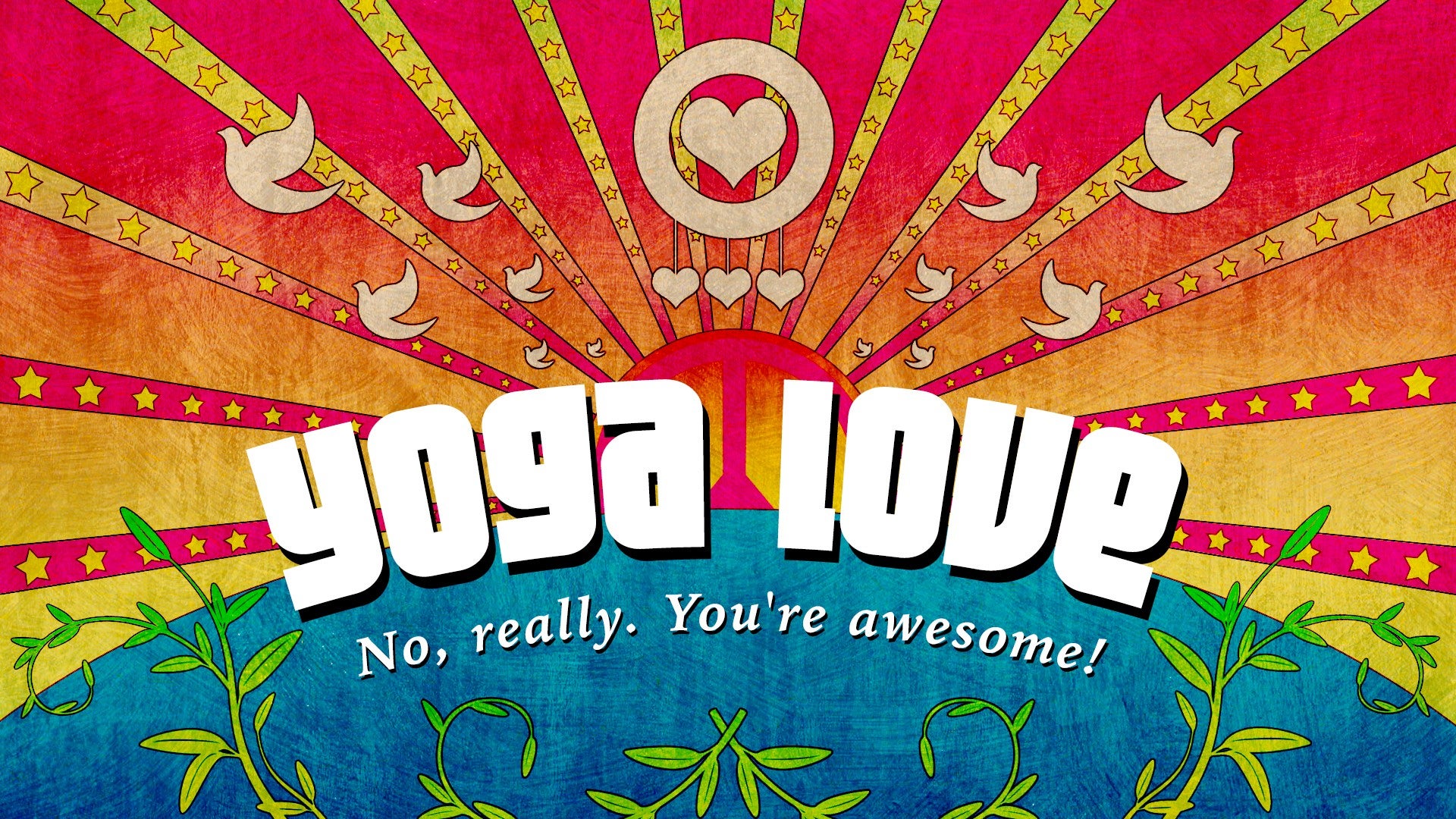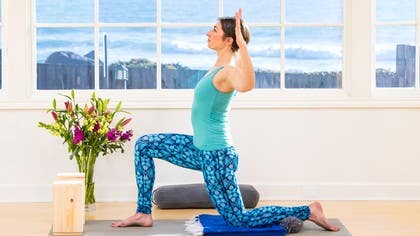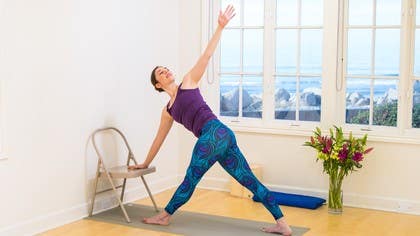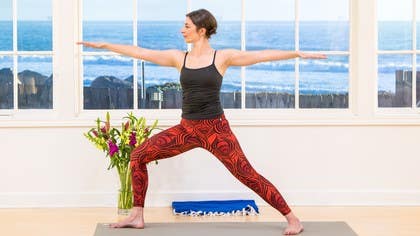Description
See the attached .pdf for a journaling exercise that goes along with this practice.
About This Video
Transcript
Read Full Transcript
(waves crashing) Jai, and welcome back. This video series is going to explore embodiment, which is one of my favorite practices. It's really about what yoga is. It's about yoking, uniting, bringing ourselves together, both in our body, in our mind, in our spirit. And I think of embodiment as this way to create the concrete form into an abstract idea.
And you might be thinking okay, well, what is that? And it's this way of being able to connect to this, through this. Because for so many of us, we try to use our mind as a way to understand and connect further to what's going on inside of us. And for a lot of us, we don't actually have language to be able to describe what's going on inside. It's a feeling state, it's a questioning, it's an inquiry, it's really just this practice.
And we have to take time to be able to figure out what this is. So the practice that we are going to move into is about exploring our ribcage. And you might be thinking okay, exploring my ribs? What is that? And it's a really fun and dynamic way of getting to know our bones, our ligaments, our muscles, and everything that holds in our breath.
So starting off in a comfortable seated position, whatever that looks like for you. So you might choose to sit on a bolster, you might choose to sit on a blanket, you might sit back on your heels, you could sit on a chair. But this practice of embodiment has to come through comfort, and a little bit of discomfort, but we'll explore that a little bit later. So find your seat. Lean back into your spine, let it support you.
Roll your shoulders down and back. Perhaps closing your eyes, or perhaps having it in a soft gaze out in front of you. Take a moment to find BRFWA. Breathe, relax, feel, watch, and allow. Just notice what's presently coming up for you.
Not changing anything. Just noticing. Notice where the shoulders are being held. Do they feel tight on your back, pressed up against the ribs? Do the front ribs feel more expanded than the back ribs?
Does the right side of your ribs have more opening than the left? Without judgment, just notice, the watching part of BRFWA. And then let's begin to experience more of a pranayama breath, dirga breath, three part breath. Create an invitation for the inhale to move into the belly. Just notice as the belly expands, on the inhale and on the exhale, feel as the belly draws back towards the spine.
And just continue with that first part of the dirga breath. Witnessing, feeling, and allowing the breath to expand into the belly. And it might feel really tight, that's okay. This is an embodiment practice in itself, just trying to feel the belly rise and fall. And then perhaps adding on.
You can always just stay with one, if that is what works for you. But let's expand into the dirga breath by inhaling the belly and then inhaling the mid-chest, or ribs. And then exhaling the mid-chest and ribs, and then exhaling the belly. And just following that, inhaling through the belly, and then into the mid-chest, and then exhaling mid-chest, and then exhaling belly. Are you breathing more in the front of the body, or the back of the body, or the sides of the body?
And could you find a fullness of both front sides and back? So adding on, beginning to connect to the third part of the breath, which is the upper chest clavicle area. So breathing into the belly, inhaling, and then inhaling into the mid-chest, and then inhaling into the upper chest. And then exhaling upper chest clavicle area, and then exhaling mid-chest, and exhaling belly. And just continue to play with those three parts.
One thing that I like to notice in this dirga breath is where do I feel stuck. Where is it difficult for me to breathe? And I might hang out in that area for a little bit. And just continuing at your own pace. And at the bottom of your next exhale, we'll begin some movement.
The movement we're gonna start off with is a sun breath. Really simple, just finding some movement of the arms, and connecting the movement with the breath. So we'll just begin by extending the arms out fully, and then up towards the sky, and at the top, you might just pause and feel some lengthening of your rib cage up towards those fingertips. And then on the exhale press the palms together, and bring the hands down towards the heart center. That's it, just finding movement in the arms, the inhaling, taking the arm bones up towards the fingertips, and on the exhale, bringing the hands down back towards the heart.
And just continuing at your own pace, finding that full movement through the arm bones up to the fingertips, maybe lengthening as much as you can to bring the hands back down through the heart. And be exploratory, just find. Maybe there's one arm that lengthens more than the other. Is there freedom happening in the shoulder girdle? Is there movement happening in your ribs?
And is the breath still there? Let's just take two more rounds. Finding it on your own. Just a full body movement here, rooting up from the floor, and one last time. The next time, when the arms extend up towards the sky, you're just gonna pause right there.
BRFWA, breathe, relax, feel, watch, allow. Just notice as the arms extend up towards the sky, what is your relationship to gravity? What about the pelvis, what about those ribs? What about the arms and the fingertips? And then we're gonna move to a side bend.
On your next exhale, releasing the right hand down towards the floor, full palm plant if you can, you can choose to have a block underneath the palms, if that works for you, and then reaching the left fingertips up and over. Just noticing here you might walk the hands out a little bit further if you have space, and then pressing the palm down towards the floor, and softly over to the right, helping to expand through your left ribs just a little bit more. I like to think about the gills of a fish. Just as if you were a fish, can you breathe and expand through those gills? Opening through the left side.
And just do what is right for your head, you could drop it, you could keep it at center, you could take the gaze up, whatever works best for you. Two more full breaths. Where is the backside of your body? Then with your next inhale, we're gonna take a shoulder opener by just letting the arm drop forward across the body, over to the left, back, up and over. Just some nice circles, some nice shoulder rolls here.
And one thing that I like to explore here, is the relationship between the shoulder girdle and the ribs. Would you be able to separate the two? Would you be able to feel the difference, and embody the difference between the two parts of the body? You might notice you can get the whole body rotating in it, or you could just get the arm rotating in it. Just feel what's best for you.
Breath full. And then the next time the arms comes toward the left side of the body, go the opposite direction. Does this feel any different, does it give you any other feedback that might be helpful for you? The gaze might follow the fingers, the gaze might look forward. And one big circle and then the arm'll come right back up towards that left ear, go ahead and pause, breathe one more time into the left side of the body.
And then exhale, root down, and come back upright. Reach those fingertips to the sky, feel the length, and then exhale, let's go to the other side. Left hand touching down, right arm reaching up and over the right ear, and find what's comfortable. Again, walk your hand out if that's what you need, pressing it down into the floor and lengthening it towards the left side of the room. Perhaps feeling the right hip settle towards the floor, whatever would bring you the most awareness in your body.
Can the breath become full? Can it expand into the right lungs and the right ribs, finding those gills once again? Does the backside of your help in the exposure to the ribs? Or the right side? If something could soften, what could soften?
Let's take the shoulder opener, letting the arm drift down across the front of the body, over towards the right side, back and around. And you might just take a couple of shoulder rolls to figure out what is best for this side, it might be totally different than the left side. So you might need a little bit more movement of the chest, you might need more stability from the spine, to help support the shoulder and the ribs. But this is your practice, just notice what would be right for you. Where has your breath moved?
And can it expand just a little bit more? And next time that your right arm sets itself towards the right side of the body, let's go the opposite direction. Reaching the fingertips forward, up over the ear, back and around. You might even feel a really nice stretch in the pectorals, the front side of the chest and collarbones. One more deep round.
And then the arm comes back up and over, let's find another reach, expanding into the right ribs, one full phenomenal breath, into the right lungs, and then at the bottom of the exhale, root yourself down, reach back up, fingertips to the sky, maybe the gaze looks up towards the sky, open the heart, and then exhale, bring the palms together, and hands down towards your heart, just connect for a moment with your heart space. And then we're gonna take some movements of the ribs. I absolutely love this one, especially after a long day. So we're gonna try to free the ribs in a circular movement. And I like to think about a barrel.
And that your ribs are scraping the edge of the barrel. And your barrel could be small, it could be very large, but whatever size it is, imagine every bit of the barrel being scraped by the ribs. So you might choose to have your hands down at your lap, you might choose to have your hands at your hips, but would you be able to free the ribs, both in the front sides and back of the body? And it might feel a little sticky, it might feel hard, it's okay. It's just a practice, it's just living an inquiry and the questioning of what's going on.
And the circle might go a little bit faster, it might go a little bit slower, it's just finding that sweet spot. And can the breath support the movement? And the next time that your chest comes forward, you're gonna pause, and then go the other direction. And one side might feel more juicy than the other, or this side might feel a little bit more stuck. Just noticing.
Can you let go of any of that inner judgment or inner critic that might pop up on the other side? And the next time that you come into a neutral spine, go ahead and pause. Let it out, shoulders can roll, head can shake from side to side, just pause with the residual, how do your ribs feel currently? And then let it all go, and we're gonna find ourselves on our hands and our knees, in tabletop position. And when we come into tabletop position, you can choose any prop that you would like for support of the knees.
You could choose your bolster, or you can choose a blanket. Today I'm gonna choose a blanket and set the bolster aside. So planting yourself on your hands and your knees, and just looking for support. That's all we're looking for right now. I have four limbs to support me, kinda cool.
So I can choose to find support in my right hand, I can choose to find support in my left hand, my right knee, my left knee, my shins, my feet, there's so many different points of contact with the earth, with the floor. And can I expand into those areas? Can I allow the floor to support my limbs? Just pause there for a moment. Can you feel the backside of your body, can you feel the sides of your body, how are the fullness of your ribs being supported by your limbs?
And then let's move into our cat and our cow. On your next inhale, dropping the belly down, taking the gaze up, finding a back bend, roll the shoulders back, and then exhale, and round into your cat pose. I like to think of a Halloween cat. And then inhale and find that back bend again, and we're just gonna continue in cat and cow, cow and cat, and I'm going to invite you here to bring your awareness to the fullness of your ribs. How do the ribs guide you in this movement, in this motion?
How do the ribs find their fullness, their opening, their softening, or their strength or their hardening? Does it support the heart? Does it support the backside of the heart? And one more round of both, of cow, and of cat. And then find neutrality.
Next we're gonna rise up to celebration pose, and for some people, this is a difficult transition. So you can feel free to either use a chair or blocks. I have these specialty blocks that are a little bit longer and wider for support. You can use whatever block, chair, anything that you have around that will give you the support to rise up. So you could even choose to do cat and cow here, as well, if you needed some extra space, due to your belly or anything else that might be preventing you from really feeling into the posture.
Feel free to use any prop that could support you in that. So in coming up with the celebration pose, if there's any other support you might need for your knees, you can grab a bolster, you can grab a million blankets, whatever it is that would support you. Another thing that some people like to use is a support for the ankle. And I'm gonna grab that for myself really quickly. You can take a rolled-up towel, you can take whatever it is, a pillow that you might need, and slide it underneath the ankles.
So in coming up to celebration pose, having yourself set up, something that's gonna support the knee, that's gonna support the body, and then from there, drawing in towards your navel, in towards your spine, and rising up to your knees. And then we're going to start in celebration pose by just lifting the arms up and over. Rise up through the back ribs, extending up through the fingertips, and then exhale, bring your hands down to your hips. And you're going to step your right foot forward, into our first low lunge. If it's difficult for you to step your right foot forward on its own, I know it's somewhat of a balancing act to be able to get the foot there, you're more than welcome to come back down onto the blocks and swing the leg around, just another way of entering into the pose, you can pull the belly aside to create more space, you can walk the foot in, and get cozy.
If there's compression of your body, that's fine. In fact, compression can be a really beautiful way of finding massage and a way of embodying parts of your body that maybe you don't make contact with very often. So once you have found the right foot has settled to the floor, find the fullness of your foot. And then press yourself up into the low lunge. Now if you still have knee issues, if there's still pain that is happening in your knee, let's find another way to support it.
And the way that we can do this is by tucking your back toe, bringing your hands to the block, lifting the back knee, and coming into a high lunge. If you need support you can bring yourself to a wall, and bring a hand to support you in that balance. This might be a little bit more difficult too. You can have a softer bend into the knee, if that's what you wish. If not, let's meet each other down in low lunge.
Knee on the floor, toes untucked, I'm gonna bring the blocks forward so you can see me a little better, rising up, fingertips to the sky. We're gonna start off with goalpost arms. Goalpost arms are just bending into the elbows, and bringing the backside of the hands to point back behind you. Press the back of the hands behind you, open up through the chest, open up through the collarbones, maybe the gaze looks up, take a full breath. And then inhale, arms rise back up, lift the ribs up and away from the pelvis, and then exhale, bend back in, goalpost arms.
Inhale arms rise, exhale, bend the elbows, and draw 'em down the back. Inhale, arms rise up, exhale, shoulders drift down towards the hips, last time. Inhale, arms rise, exhale, bend the elbows. Reach through your heart, draw your ribs up and away as the shoulders draw down and then inhale, bring it back up. Full breath, just feeling into the support of your body.
And then we're gonna come into a side bend, on your next exhale you can bring your right hand either to your right thigh, or take hold of your block, bringing it to the side, and then inhale, side bend. Left arm reaching up and over, left fingertips over towards the right side of the room. Couple of breaths. Similar to when we were in a seated position, can you breathe into your ribs, can you breathe into the gills of your body? One more full breath.
And then at the bottom of your next exhale, press into the floor and inhale, rise back up, and exhale, bring the hands either back to your block, either way we are gonna step ourselves back into celebration pose. Fingertips to the sky. And exhale, arms down. On the next inhale, stepping our left foot forward, to the other side in low lunge, again you can choose to use your blocks, swinging the foot around, bringing it to the floor, maybe pulling the belly aside, feeling a little bit of the compression, again, that's okay. Or you might just step the foot forward.
Little bit of a balancing act there. Again I'm gonna move the blocks forward so you can see what I'm doin' here. And inhale, arms rise up towards the sky. On the exhale, goalpost arms. Let the elbows drop, just pause there for a moment, let the collarbones open, feel the connection of the shoulders on top of the ribs.
And then let's find a little bit more movement. Inhale, fingertips rise up, and exhale, elbows bend. Inhale, arms rise up, and exhale, shoulders down the back. Good, three more times, just like that. Finding freedom here through the movement of the breath, through the movement of the shoulders, the movement of the arms.
I have one more, I don't know how many you have, but I have one more, and I'm gonna take it, and I'm going to extend through that heart, lifting up through the ribs, and then fingertips rise back up, and exhale, hands plant themselves back to the blocks, stepping the foot back, celebration pose. Again you don't have to use the blocks if you don't want to. Inhale, arms will lift one last time in that celebration pose, and then exhale, we're gonna come back down into tabletop position, choosing to use the blocks or not. I'm gonna set them aside. Along with the support of my ankles.
And back into tabletop. Let's find cat and cow again, and just see if there's a change, a difference, something else that exposes itself to you in the movement. So inhaling, dropping the belly, taking the gaze up, finding that back bend. And exhaling and rounding back into that cat. And as you explore here, there may be a different movement that calls to you.
For instance, I'm feeling the desire to move my ribs back in that circular motion that we began the series with. And just take a couple of breaths to just notice how the ribs can move in space. And there might be a part of the ego or the mind that prevents you from getting there, and just see if you could let go of the mind, and just experience the movement. Just imagining that there's nobody looking, and that you can find some freedom. Could you find each and every rib?
And when there's a moment to pause, just go ahead and pause. And when there's the invitation to let go, we'll meet in sukhasana, cross-legged position. Choosing to use the prop that is supportive for you, as you make your way to your seat. And if there was another seat that was more comfortable for you, take that. Find the comfort, lean back into your spine.
And I'm feeling drawn to placing one hand on my heart, and one hand on my belly, but if there is another position for your hands, go ahead and take it. Can you just notice the reverberation of your practice? That might mean closing your eyes, or having a soft gaze. What is it that you feel? Is that feeling stayed only in the ribs?
Is it in your heart? Is it in any other system of your body? Just hold it, be with it. Sit with it. We'll just take the next little bit to sit in silence and just notice for ourselves what arises.
If you wanna stay in this space, stay in this space. If you want to move on, let's meet one another with our hands at our heart, in anjali mudra, prayer. And then bowing your brain to your heart, your heart to your body. Giving thanks to our bodies for speaking, for supporting, for everything that they provide. Thank you so much for sharing your practice.
Namaste.
Yoga Love: Love Your Body
Comments

You need to be a subscriber to post a comment.
Please Log In or Create an Account to start your free trial.














